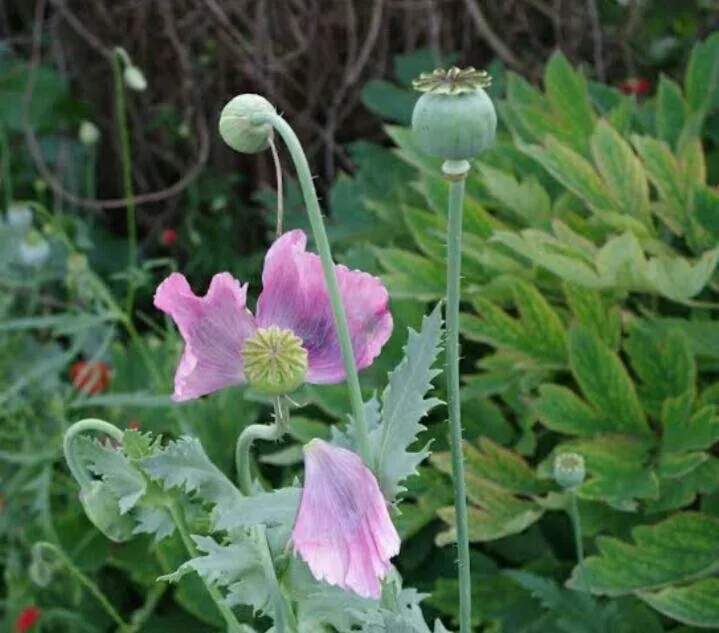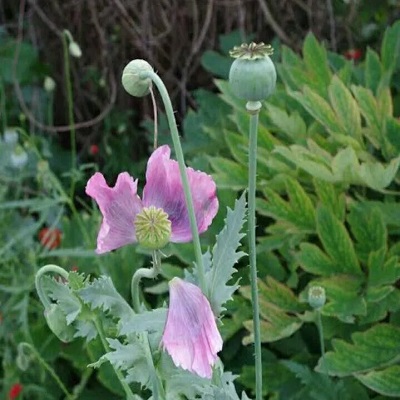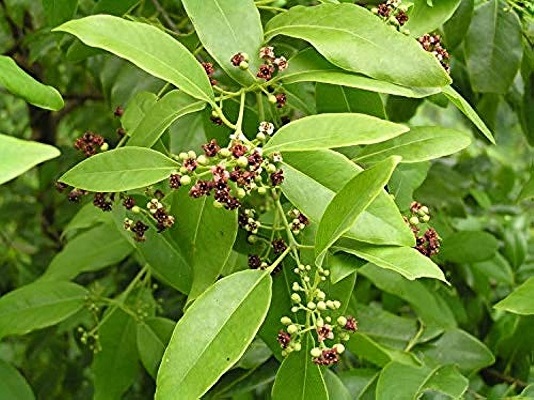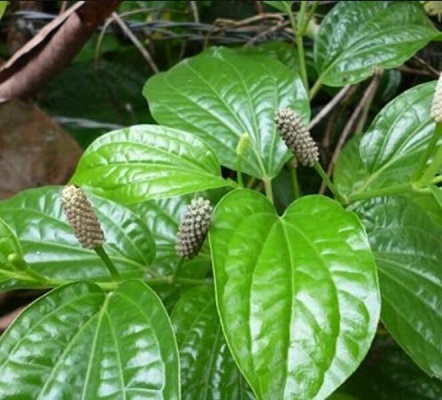On This Page
Ahiphena – Papaver somnifera
Introduction
Ahiphena, commonly known as Opium or Poppy seeds is one of the most potent herb used as an Analgesic and Sedative. The name Ahiphena means that the latex of this plant is very strong like venom of Cobra. The genus name Papaver indicates that it belongs to Papaveraceae family and the species name somnifera means it produces sleep. The latex and juice of this plant is used in different skin allergic conditions.
Dr. Gupta’s IAFA have been studying on readily available herbs for the purpose of alleviating allergic condition. Our experts studied on Ahiphena and proven the plant’s therapeutic activities like Analgesic, Hypnotic, Antiallergic, Sedative, Narcotic, Respiratory depressant, Cough reflex depressant, Emetic etc. Ahiphena can be used in various diseases like emaciation, dandruff, diarrhoea, pain, cough, insomnia etc. The main alkaloids obtained from Opium are morphine and codeine. These are used as narcotic and analgesics. Some people shows IgE mediated Opium allergy which can lead to asthma. But the seeds of Opium is also useful in allergic reactions on skin and scalp.
Action of Ahiphena – Papaver somniferain Allergies
IAFA experts have successfully proven the antiallergic property of the plant Ahiphena. The plant contains c etc. These phytoconstituents aids the antiallergic and analgesic property of Ahiphena. Ahiphena seed paste with milk can be effectively applied on the skin and scalp to alleviate allergic conditions.
Vernacular Names
| Sanskrit Name | तिलभेद, खसतिल और खाखस |
| Hindi Name | Kashkhas |
| English Name | Opium, Poppy seeds |
| Malayalam Name | Karuppu |
| Kannada Name | Aphimu |
| Marathi Name | Khaskhas |
Botanical Name
Papaver somnifera
Family
Papaveraceae
Morphology of Ahiphena – Papaver somnifera
- An annual quite glabrous herb.
- Leaves oblong.
- Flowers white, sometimes purple or scarlet.
- Seeds white or black.
Ayurveda Reference of Ahiphena – Papaver somnifera
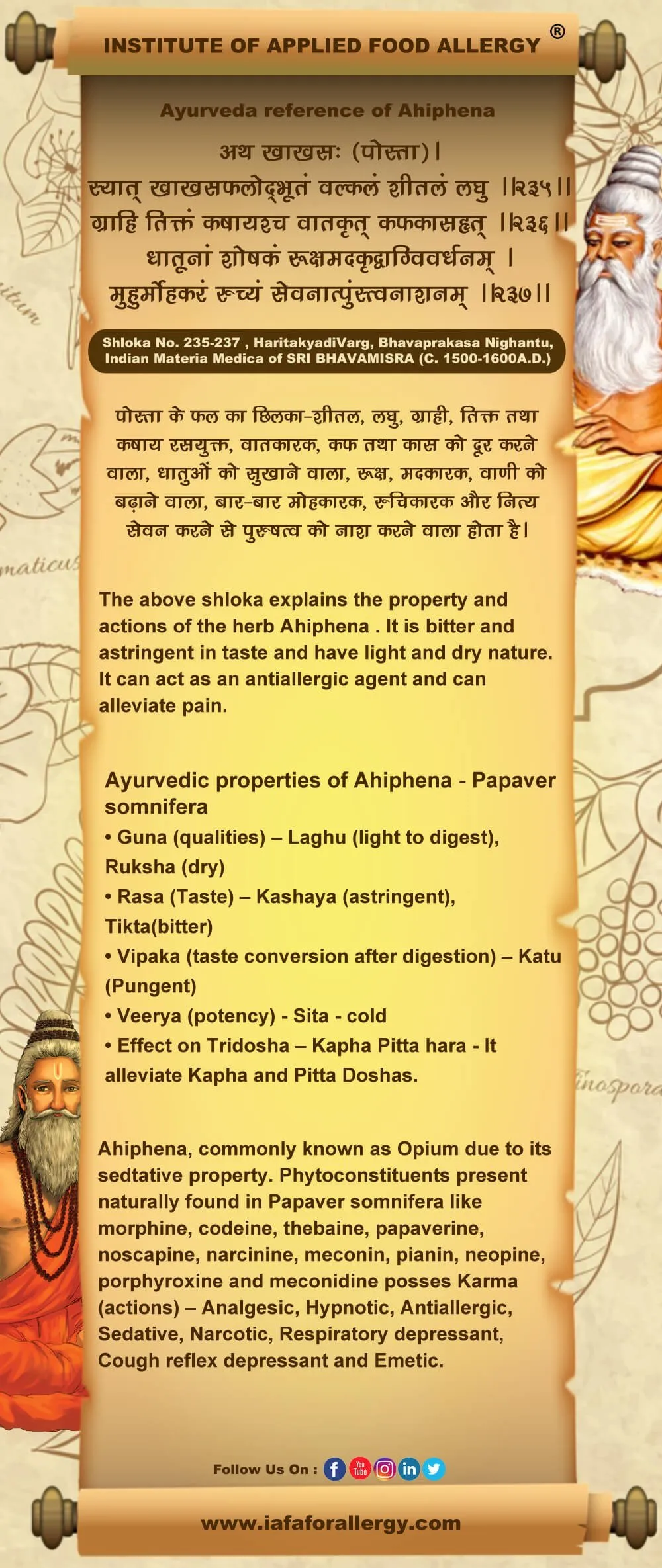
Geographical Distribution of Ahiphena – Papaver somnifera
It is commonly found in Northern subtropical regions and Asia minor, Persia, China, Nepal and India. In India it is a specially cultivated in Uttar Pradesh, Punjab, Madhya Pradesh, Rajasthan, Tamilnadu, West Bengal, Bihar, Jammu and Kashmir and Assam.
Phytoconstituents of Ahiphena – Papaver somnifera
The plant contains phytoconstituents like morphine, codeine, thebaine, papaverine, noscapine, narcinine, meconin, pianin, neopine, porphyroxine, meconidine etc.
Parts Used of Ahiphena – Papaver somnifera
- Latex
- Seeds
Dosage of Ahiphena – Papaver somnifera
- Powder (Churna) – 1-2 g
- Seed (Bija) – 2-5 g
- Latex (Aphim) – 30-125 mg
Medicinal Properties of Ahiphena – Papaver somnifera
- Kasahara – relieves cough
- Vedanasthapaka – analgesic
- Sophahara – relieves swelling
- Madaka – create excitement
- Nidrajanaka – induces sleep
- Ruchya – relieves anorexia
- Agnivardhaka – improves digestion
- Vrsya – aphrodisiac
- Balya – promote strength

Have A Health Issue?
Consult Online
- Dr. Sahil Gupta (B.A.M.S., M.H.A.)
Ayurvedic Allergy Specialist
CEO & Founder of IAFA®
Home Remedies of Ahiphena – Papaver somnifera
Ayurveda is an ancient system of medicine which focused on lifestyle modifications along with medicines in treating diseases. The treatment system adopted by Ayurveda is purely based on naturally available herbs. Ahiphena is one of the commonly growing plant and due to its high medicinal value it is used in treating many diseases like:-
- In dandruff (Daruna) – A paste is prepared from Ahiphena seeds and milk and applied over scalp.
- In Diarrhoea (Atisara) – Ahiphena is mixed with bark of Strychnosnuxvomica and honey and taken.
- In Skin diseases (Kushta) – Ahiphena seeds and milk is made into a paste and applied over skin.
- In Insomnia (Anidra) – Ahiphena latex is taken in mild doses to cure insomnia.
- In Pain (Sula) – Latex or fruit of Ahiphena is used to relieve pain.
- In Cough (Kasa) – Latex of Ahiphena is taken to cure cough.
- In Debilitating diseases (Dourbalya) – Seeds of Ahiphena is taken with milk.
Ayurveda is an ancient Indian system of medicine which uses herbs that are seen all around. Dr. Gupta’s IAFA have been conducting research studies to find out different phytoconstituents of herbs and their action in body. Such knowledge acquired by our experts are used in preparation of medicines and providing better treatment. IAFA is the provider of safe and effective treatment for a wide range of diseases, mainly allergic diseases all based on Ayurveda.
Reach IAFA for safe herbal remedies for all your ailments!!!
Was this Page Helpful?
Read More Articles
-

Kasini (Cichorium intybus)
Kasini (Cichorium intybus) commonly known as Chicory is a perennial herb, with large…
-
-

